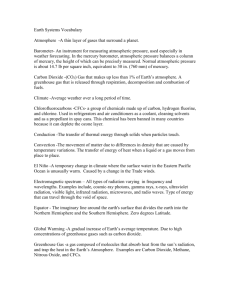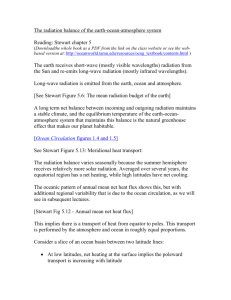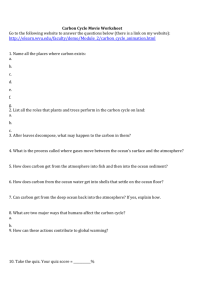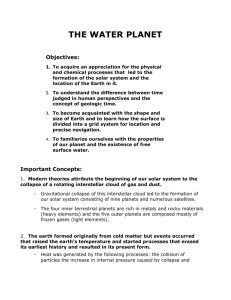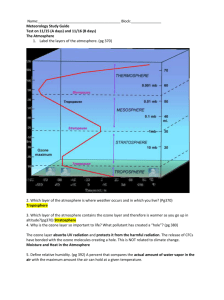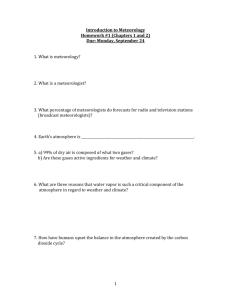1 - SeptemberPLC
advertisement
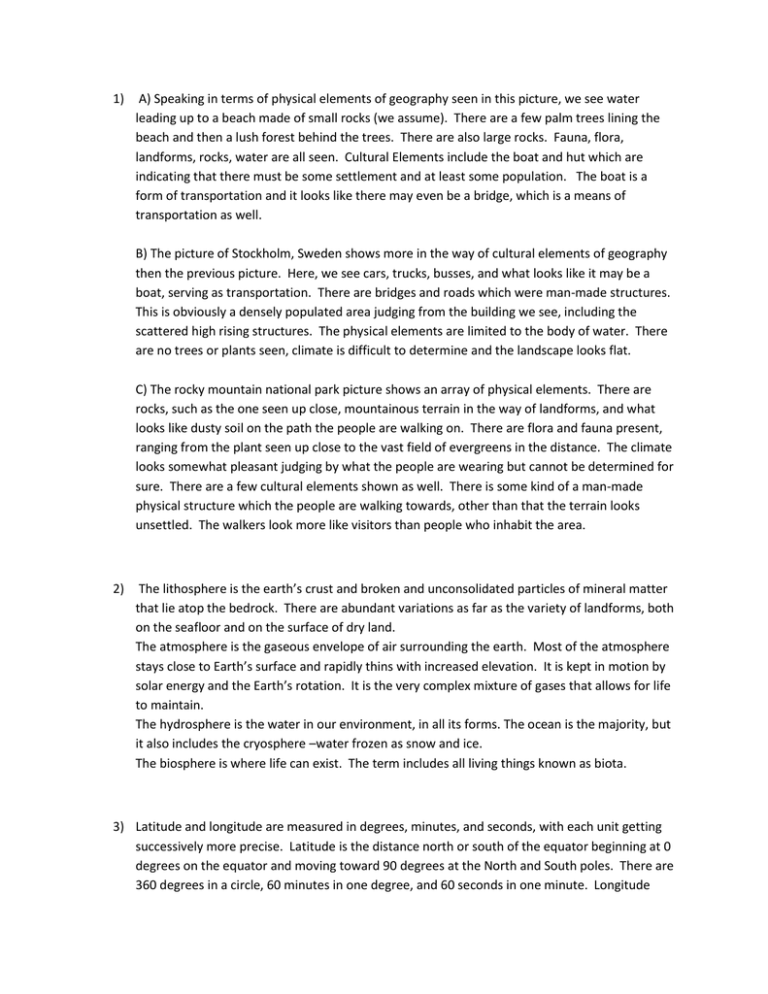
1) A) Speaking in terms of physical elements of geography seen in this picture, we see water leading up to a beach made of small rocks (we assume). There are a few palm trees lining the beach and then a lush forest behind the trees. There are also large rocks. Fauna, flora, landforms, rocks, water are all seen. Cultural Elements include the boat and hut which are indicating that there must be some settlement and at least some population. The boat is a form of transportation and it looks like there may even be a bridge, which is a means of transportation as well. B) The picture of Stockholm, Sweden shows more in the way of cultural elements of geography then the previous picture. Here, we see cars, trucks, busses, and what looks like it may be a boat, serving as transportation. There are bridges and roads which were man-made structures. This is obviously a densely populated area judging from the building we see, including the scattered high rising structures. The physical elements are limited to the body of water. There are no trees or plants seen, climate is difficult to determine and the landscape looks flat. C) The rocky mountain national park picture shows an array of physical elements. There are rocks, such as the one seen up close, mountainous terrain in the way of landforms, and what looks like dusty soil on the path the people are walking on. There are flora and fauna present, ranging from the plant seen up close to the vast field of evergreens in the distance. The climate looks somewhat pleasant judging by what the people are wearing but cannot be determined for sure. There are a few cultural elements shown as well. There is some kind of a man-made physical structure which the people are walking towards, other than that the terrain looks unsettled. The walkers look more like visitors than people who inhabit the area. 2) The lithosphere is the earth’s crust and broken and unconsolidated particles of mineral matter that lie atop the bedrock. There are abundant variations as far as the variety of landforms, both on the seafloor and on the surface of dry land. The atmosphere is the gaseous envelope of air surrounding the earth. Most of the atmosphere stays close to Earth’s surface and rapidly thins with increased elevation. It is kept in motion by solar energy and the Earth’s rotation. It is the very complex mixture of gases that allows for life to maintain. The hydrosphere is the water in our environment, in all its forms. The ocean is the majority, but it also includes the cryosphere –water frozen as snow and ice. The biosphere is where life can exist. The term includes all living things known as biota. 3) Latitude and longitude are measured in degrees, minutes, and seconds, with each unit getting successively more precise. Latitude is the distance north or south of the equator beginning at 0 degrees on the equator and moving toward 90 degrees at the North and South poles. There are 360 degrees in a circle, 60 minutes in one degree, and 60 seconds in one minute. Longitude 4) 5) 6) 7) 8) 9) does the same thing but measures East-West. Together, latitude and longitude form a grid of the entire earth, allowing us to easily identify where any one particular point is. The Earth’s rotation gives rise to the daily alteration of light and darkness. This variation in exposure to sunlight influences temperature, humidity and wind movement. If the earth didn’t rotate we would have areas of the earth that were light all the time and areas that were permanently dark. Revolution causes the earth to revolve around the sun, at first this seems to have little effect on seasonal changes but when combined with inclination and polarity, revolution and rotation do impact seasonal changes. If the earth did not revolve then we would not get seasonal changes at all. The earth would remain rotating, with night and day, but would never vary in distance from the earth. Inclination is the world’s tilt. If the world were not tilted, but were instead even with the plane of the ecliptic, we would have identical temperatures going away from the equator in each direction. The axis of Earth always points in the same direction, without this consistency, known as parallelism, seasons would rotate entirely different. They would still happen, but not the way we know them to occur today. Perihelion is the point where the earth is closest to the sun, it occurs on about January 3rd at 91,455,000 miles. Aphelion is when the Earth is furthest away from the sun, occurring around July 4th at 92,955,806 miles. The vertical rays of the sun strike directly on the Tropic of Cancer (23.5 degrees north of the equator) on the June Solstice. This is the day when the solar altitude would be 90 degrees. The earth does not tilt any more than this. Conversely, the vertical rays of the sun never go below 23.5 degrees south of the equator. This is the December Solstice, where the North pole is the furthest away from the sun. The Arctic Circle experiences its longest day of the year on the June Solstice and we call this day the summer solstice. The Antarctic Circle experiences it shortest day of the year and they call this day the Winter Solstice Seasonal changes are less noticeable because temperatures stay within a steady range at the equator during all seasons. Away from the equator we see greater fluctuations in daylight hours and temperature changes during the different seasons. The day lengths are becoming shorter on this day, August 8th, in the Northern Hemisphere. LAB EXERCISE 2 PART I 1) A) Chicago= 41 north 87 west B) Tokyo= 35 N 139 E C) Sydney= 34 S 151 E D) Singapore= 1 N 103 E E) Buenos Aires= 34S 58W 2) A) Bangkok Thailand B) Moscow, Russia C) Thalnepantla, Mexico D) Nairobia, Kenya E) Aukland, New Zealand LAB EXERCISE 2 PART II 1) Is attached to this document!! 2) a) 35 N 130 E b) 19 N 110 W c) 23 S 14 E d) 8 S 178 E 3) 40000/360=111.11 x 10 = 1111.11 kilometers, is how far North of the equator you would be at 10 degrees North latitude. 4) Simply put, the answer is because the world is round! If you are traveling along the equator, then you are traveling at the “fattest” part of the sphere. If you begin your travels at 60 degrees N latitude then you would be traveling a far shorter distance in order to move ten degrees of longitude. A gridded sphere will have much smaller individual gridded units as you retreat away from the area to measure circumference. LAB EXERCISE 7 PART I 1) 23.5 degrees N 2) A) 66.5 degrees N B) 66.5 degrees S 3) The Southern Hemisphere is tilted away from the sun’s energy. 4) A) Because half of the equator is in light and the other half is in darkness. B) This is where the circle of illuminations shows the difference between night and day. C) Yes, at the Arctic circle. LAB EXERCISE 7 PART II This section is attached and labeler 7:2 LAB EXERCISE 8 PART I 1) a) 22 S b) 6 S c) 17 N d) 19 S 2) a) 22 S; 22 degrees; 68 degrees b) 6 S; 44 degrees; 46 degrees c) 17 N; 87 degrees; 3 degrees 4) March 29: 3 N; July 3: 23N; October 14: 8S; 87; 67; 82; daylight daylight darkness Unit 2 1. What are the four layers of the atmosphere based on temperature? Describe the pattern of temperature change with altitude within each layer. What is the heat source within each layer, if any? (9 points) The Troposphere, Stratosphere, Mesosphere, and Thermosphere. The Troposphere averages about 60 degrees (Fahrenheit) at its lowest point and steadily decreases to an average low of about -70 degrees at its highest point. It is heated in part because the earth’s surface absorbs solar radiation and transfers this heat to the air. The lower Stratosphere’s temperature remains fairly constant at about -70 degrees, but then begins to increase sharply, reaching about 65 degree toward the top, the heat is due to increased ozone concentration which absorbs ultraviolent radiation. The Mesosphere cools steadily as we rise in elevation, to temperatures as cold as -225 degrees. There is no heat source in this layer. The Thermosphere is warmed due to various atoms and molecules absorbing ultraviolent rays from the sun and thus splitting and heating. Temperatures steadily rise in this layer to the extreme level of 3600 degrees. Rises is temperature in the various layers of the atmosphere are due to the heating sources mentioned, areas that are cold simply lack these heat sources. 2. Describe the trend in atmospheric pressure as altitude increases. What is the reason for this trend? (3 points) A general rule is that pressure decreases upwards at a decreasing rate. Atmospheric pressure can be simplified as the weight of the overlying air. The taller the column of air exerting pressure on the air bellow, the greater the atmospheric pressure. It makes sense that at the very lowest altitude we find the highest pressure because the lowest point would have the greatest amount of air above it, causing the highest pressure. The reason we find pressures decreasing at a decreasing rate going up is because most of the mass of the atmosphere is found relatively close to ground level. 3. What is ozone? What are the differences between "good" ozone and "bad" ozone? (5 points) Ozone is a form of oxygen molecule consisting of 3 atoms of oxygen, rather than the more prevalent two atoms, what we call O-2, ozone is O-3. Ozone is created in the upper atmosphere due to ultra-violet solar radiation’s impact on O-2 molecules. Generally, we say that ozone high up is good, ozone closer to us is bad. The ozone in the Stratosphere protects plants and animals (including us) by block harmful rays of the sun which cause skin cancer, among other things. In the troposphere ozone does not naturally occur at harmful levels in this area, but human activities has caused its rising accumulation. Ozone is 0-3 either way, but the difference is in where it accumulates. 4. What are the three most abundant gases in the atmosphere? In contrast, how much water vapor and carbon dioxide is present in our atmosphere? Explain why these two gases are so important to weather and climate patterns. (4 points) The three most abundant gases are nitrogen, oxygen, and argon. Water vapor 0-4 percent of volume of dry air. It has a significant impact of weather and climate because it is the source of all clouds and precipitation. It also plays a major role in a number of heating and cooling processes in the atmosphere. Carbon dioxide plays a significant role in the weather and climate primarily due to its ability to absorb infrared radiation and therefore help to warm the lower atmosphere. It accounts for .038% of volume in the atmosphere, but that number is considered to be on the rise my most atmospheric scientists. 5. How is weather different from climate? What are the four "basic ingredients" of weather and climate? (3 points) The term weather refers to short term atmospheric conditions for a given time in a specific area. Weather is an ever-changing state, sometimes seemingly erratic and we generalize these patterns into a composite pattern which we call climate. Climate essentially summarizes not only the averages but the variations and extremes. 4 basic ingredients= temperature; moisture content; pressure; wind. 6. Describe the major factors controlling climatic variation over the Earth's surface. (7 points) Latitude; the continuously changing positional relationship between the sun and the earth brings continuously changing amounts of sunlight and radiant energy to different parts of the earth’s surface. Thus, first and foremost the distribution of heat is a product of latitude. Distribution of land and water; because oceans heat and cool more slowly then do land masses, maritime areas experience milder cold periods and milder heat periods than do landlocked areas. Ocean areas are also typically more humid General circulation of the oceans; ocean currents assist in heat transfers and they assist in moving cooler water equatorward and warmer water poleward. Altitude; this has major implications in mountainous regions, as we rise in elevation we see temperature, pressure and moisture generally decreasing in the troposphere. Topographic barriers; mountains and large hills can effect climate by diverting wind flow. Storms; they create specialized weather circumstances and so they are considered a control, some storms are prominent enough to not only effect weather, but to effect climate as well. LAB EXERCISE 1 PART I 1) a: 13.1 b: 95.1 2) a: 7.6 b: 1.3 H: 70.4 c: 108.7 d: 44.4 c: 16.5 i: 8.3 LAB EXERCISE 1 PART II 1) 72cm= 28.4 24m= 78.7 1300km= 807.3 e: 2 f: 143.3 g: 98.6 d: 117.5 e: 5.9 f: 37.9 g: 396.9 4.5l= 4.8 144g= 5 228kg= 502.7 12degrees C= 53.6 2) 55Inches= 139.7 1774 ft= 541.1 220yds= 201.1 23900miles= 38,455.1 24qts= 22.7 300gallons= 1,135.5 26 oz= 737.1 4500lbs= 2043 88degrees F= 31.1 LAB EXERCISE 4 PART I 1) 24,000 inches or 2000 feet 2) 62500 x 4.5 = 281,250 / 63360 = 4.438 miles 3) 250000 x 4.5 / 63360 = 17.75 miles 4) 50000 x 7.5 / 100000 = 3.75 kilometers 5) 9 statues miles 13 kilometers 6) 24000 x 3 = 72000/12 = 6000 ft or 1.13 miles or 1.8 km LAB EXERCISE 4 PART II 1) 1:31,680 2) The “0” is not always on the far left of scales on graphical scales. I could not find why is the book, but I would wager a guess that having room going the other way allows someone to see the distance going in the opposite direction more easily. 3) The fractional scale of the map would still work fine. As long as both were enlarged at the same proportion to another then it would still be to scale. The distance between two points would change in inches but in relation to each other in real life and in the representative section being shown on a graphical scale would remain equal. 4) Yes they would still be usable as long as the map were made for it and blown up/shrunken at the same rate. LAB EXERCISE 6 Fahrenheit A=70 B=55 C= 80 D= 75 E=80 F=50 G=35 H=80 EXERCISE 6 PART II is attached and labeled EX6 PT2 Unit 3 1. Your text states that there are three areas of the electromagnetic spectrum that are of particular importance to physical geographers. Describe these three areas, and why they are important to physical geography. Are these areas considered short-wave radiation or long-wave radiation? (7points) Visible light, ultraviolet radiation, and infrared radiation. Visible and ultraviolet radiation are considered short-wave radiation. Infrared radiation ranges from short-wave and is part of solar radiation, to longwave radiation emitted by the earth; terrestrial radiation. Visible light are wavelengths of light to which the human eye is capable of responding. They are between 0.4 and .7 micrometer wavelengths. About 47% of the total energy arriving at earth from the sun are in the form of visible light. Ultraviolet radiation are wavelengths just shorter than the human eye can sense. The sun is the major source of ultraviolet radiation as well, although much of this radiation is actually absorbed by the ozone layer. Infrared radiation are wavelengths just longer than the human eye can sense. They range from on the shorter end emitted by the sun, to on the longer end, thermal infrared, emitted by the earth. 2. Define the processes of conduction, convection, advection, and latent heat transfer. Each of the four processes are at work in the following scenario. Identify one example of each process from the following paragraph (be creative!): (8 points) It is a windy March evening. Chucky has just left the recreation center after a particularly intense workout. He sits down on the cold concrete steps outside the library to wait for a friend. They are going to study for the Climate & Vegetation midterm. It's a chilly night, and Chucky can see his breath in the night air. He shivers and wonders why his friend is taking sooooooooo long!!! The concrete Chucky sits on is cold due to conduction. Convection is allowing his body heat molecules to physically move away from Chucky’s body. The reason Chucky feels particularly cold during this windy evening could be because of advection, the wind is causing cooler air to circulate and hit Chucky’s skin. He can see his breath because of latent heat. 3. One of the most important phenomena in the lower atmosphere is the greenhouse effect. Explain processes and gases involved, and why the greenhouse effect is so important to life on Earth. Explain the difference between the greenhouse effect and global warming? (4 points) A number of gases in the atmosphere, including water vapor, carbon dioxide and methane, readily transmit incoming shortwave radiation from the sun but do not easily transmit outgoing longwave terrestrial radiation. Shortwave solar radiation come from the sun and are absorbed into the earth’s surface, raising the temperature. However, the Earth’s longwave radiation is inhibited from transmitting back through the atmosphere by the greenhouse gases. Without the greenhouse effect the average temperature of earth would only be about 5 degrees Fahrenheit as opposed to the current average of 59 degrees Fahrenheit. Global warming is the result of human action. Global warming occurs because of the significant increase in greenhouse gases, most notably carbon dioxide, due to the burning of fossil fuels, among other things. Global warming is causing the earth’s overall temperature to rise and is a testament to the adverse effects humans are having on the energy balance of earth itself. 4. Define specific heat. Explain differences in specific heat between land and water. Why do these differences have an effect on climate? Discuss three other reasons that water bodies have more moderate climates than landmasses. (6 points) Specific heat is the amount of energy required to raise the temperature of 1 gram of a substance by 1 degree Celsius. The specific heat of water is 5 times greater than that of land. Meaning, water can absorb much more solar energy without increasing its temperature. The ocean is like a great reservoir of heat, areas inland have more extreme climates than areas close to or completely surround by water. The oceans make for moderate temperatures as compared to areas at similar latitudinal locations that are further away from the ocean. Another reason is transmission; the suns rays penetrate deep into the ocean than they do on land, therefore solar energy is absorbed by a much greater volume of matter in water. Mobility; because the ocean is so turbulent and is always mixing, the heat can be dispersed more broadly and deeply. Evaporative cooling; since moisture is unlimited on the ocean evaporation is much more prevalent than on land. The cooling effect of evaporation slows down any heat buildup on a water’s surface. 5. The graph below (Figure 4-25 from your text) shows mean monthly temperatures for Dallas and San Diego. a) Fill in the following for each city (estimate from the graph): (3 points) Dallas San Diego Average Annual Temp. ____65___ ___63____ Maximum Monthly Temp ____86___ ___70____ Minimum Monthly Temp ____43___ ___58____ Temperature Range (Max____43___ ___12____ Min) b) You'll notice that Dallas and San Diego are at roughly the same latitude, but temperature ranges are very different. Describe the annual temperature trend for each location, and explain why they are so different. (3 points) They are so different because of the distance San Diego is from the ocean. The ocean absorbs heat in the summer, making for a more mild average temperature, and then gives off heat during the winter months, making for a more pleasant average winter temperature. Both cities have similar average temperatures because they share very similar locations as far as longitude. c) You will also notice that the mean monthly March temperature is the same for Dallas as in San Diego, approximately 15ºC (59ºF). It might seem that conditions are the same in both cities for that month. Describe temperature differences that are likely to exist between Dallas and San Diego during March (think about day to day differences). (2 points) Temperature differences in March can be expected to coincide with the general trends described previously. Dallas probably has colder nights and hotter days during March, while San Diego follows the trend of experiencing more mild fluctuations in temperature. Again, this can be most directly attributed to the ocean’s effect of moderating heat distribution; absorbing heat during the day and releasing it at night. 6. Considering the normal lapse rate (6.5ºC / 1000m or .65ºC / 100 m), if the temperature in Boulder, CO is 29ºC (~ 2700 meters), what would you expect the temperature to be in Estes Park, CO (~ 4100 meters)? How about at Bethoud Pass, CO (~ 6300 meters)? (2 points) 1.3 Estes Park=29-9.1= 19.9 Berthoud Pass= 19.9-13.5=6.4-1.3= 5.1 7. Describe how air warms and cools adiabatically. (4 points) Air cools adiabatically due to the expansion that occurs in rising air. As air rises and expands, the molecules spread through a greater colume of space and this requires energy. The decrease in temperature is a result of the molecules spreading further away from each other and therefore not colliding as often. This is cooling by expansion and it happens anytime air rises in our atmosphere. When air descends it is warming adiabatically. The descent causes compression, which causes the molecules to draw closer together and therefore collide more frequently. The result is an increase in temperature. 8. What is an ocean gyre? Given the generally pattern of flow, what type of ocean current (temperature and direction of flow) flows on the east side vs. the west side of continents? (3 points) Ocean gyres flow clockwise in the northern hemisphere and counterclockwise in the southern hemisphere due to a series of enormous elliptical loops elongated east-west and centered approximately at 30 degrees of latitude. The clockwise spinning ocean current on the west side of continents causes colder water to flow from the poles toward the equator, and on the East side of continents, in the northern hemisphere, oceanic currents cause warmer water to be cycled upward from the equator. The reverse is true of continents in the southern hemisphere. EXERCISE 9 PART I + II is attached and labeled EX9 PT I + II EXERCISE 10 PART I 1) Temperature Contrast in the Arctic Region is greatest in the Winter 2) a) One region where this is observed is in the Sahara desert. b) The reason we see the hypothetical pattern stay constant because of the lack of variations in precipitiation and elevation seen in this area. Without these factors, and because this region is entirely land locked, there are no factors that would effect the climate. Also wind patterns are probably similar. 3) a) Cool ocean currents seem to have more of an effect in the summer. b) These ocean currents might have more of an effect in the summer because the ocean is able to absorb energy from the sun during hot summers. 4) a) One area of the map that displays a large temperature change between summer in winter is the area encompassed by greenland. b) The change is so different due to the nature of pole regions. Because of the tilt of the earth Northern Greenland is exposed to almost constant sun, with the North Pole receiving sunlight around the clock for a short period of time. In the winter, however, Northern Greenland would experience almost no sunlight whatsoever. With darkness occupying a majority of the day, the suns solar energy is unable to heat this area during this time period. c) Areas closer to the equator will usually experience less change in annual temperature. One example of this would be the islands just north of Australia. d) There is very little change in temperature because sunlight does not vary nearly as much along these areas. Also, since the islands are relatively small and surrounded by water the ocean will act to help sustain a constant average temperature. It will absorb the suns solar energy as needed and emit the energy during cooler periods. Unit 4 1. How do pressure gradient force, the Coriolis effect, and friction interact to determine surface wind speeds and direction? (3 points) Pressure gradient is the idea that if pressure is higher on one side of a parcel of air, the air parcel will move from the area of higher pressure towards the area of lower pressure. The Coriolis effect the direction of wind flow. In the Northern hemisphere the Coriolis effect deflects to the right and 90 degree, and the opposite is true in the Southern hemisphere. This creates an eternal battle as pressure forces air own a gradient while the Coriolis effect deflects wind 90 degrees from its path. On the surface friction also plays a role. The influence of the Coriolis effect is reduced as friction drag on earth’s surface slows wind movement. Instead of blowing perpendicular to the isobars as gradient forces would sugest, or parallel to them, as the Coriolis effect would cause, the wind ends up crossing isobars at some angle between 0 or 90 degrees. Generally the pressure gradient determines speed; if the gradient is steep the air moves quickly; if it is not so steep air will move less quickly. 2. Prepare and complete a table comparing the following characteristics of cyclones and anticyclones. Make sure to indicate where differences occur between northern and southern hemispheres. (5 points) relative pressure vertical component (i.e., rising or sinking air) horizontal component (i.e., diverging or converging air) direction of flow (clockwise or counterclockwise) likelihood of precipitation Anticyclones Relative Pressure: Relatively high pressure. Vertical Movements: Air descends. Horizontal Movement: Divergent Direction of Flow: In upper atmosphere of the Northern hemisphere the wind move clockwise parallel to the isobars. At lower elevations there is a divergent clockwise flow with air spiraling out and away from the center of the anticyclones. Southern hemisphere upper atmosphere = counterclockwise parallel to isobars. Surface layer = air diverges counterclockwise. Likelihood of precipitation: Less likely. Cyclones Relative pressure: Relatively low pressure Vertical Movement: Air ascends Horizontal Movement: Convergent Direction of Flow: In the upper atmosphere of the Northern hemisphere air moves counterclockwise parallel to isobars Air converges counterclockwise on the surface layer of the earth. Southern hemisphere upper atmosphere = clockwise and parallel. Friction layer = converges clockwise and spiral. Likelihood of precipitation: Precipitation is more likely. 3. On a map of atmosphere pressure, what does the spacing of isobars tell you about pressure gradients and wind speeds? (2 points) The spacing of isobars indicated the pressure gradient. The closer the isobars are to one another the greater the pressure gradient and therefore the higher the wind speeds. Isobars that are more spaced out indicate a lower pressure gradient and lower wind speeds. 4. Describe the three major wind belts of the general circulation of the atmosphere, the trade winds, westerlies, and easterlies. Include key characteristics of each, including location, origin and air movements. (5 points) The Trade Winds: From the Equatorward side of the subtropic high’s and diverging toward the West and towards the equator is wind system of the tropics. They cover most earth between 25 N and 25 S. Over the oceans they remain prominent but do hover on most land masses in this general vicinity. More prevalent than any other wind system. They usually flow towards the West. They usually come from the North East in the Northern hemisphere. They usually blow in the same direction at the same time at the same speed and so they are the most consistent. They can hold an immense amount of moisture. Potential for storms and precipitation, but not necessarily as they require another force to allow them to actually “dump” the precipitation that they hold. Westerlies: This wind pattern is issued from the poleward sides of the subtropic highs. Occur in the midlatitudes between 30 and 60 degrees both North and South of the equator. The winds are much less consistent and, in fact, they may come from any direction. The winds are heavily influenced by surface friction, topographic barriers, and especially from migratory pressure systems. Easterlies: Located from the poles to about 60 degrees of latitude. The winds are cold and dry but are also variable. However, they do generally move from East to West. They help give rise to Polar Fronts. 5. Discuss the formation of the ITC and subtropical highs. What are typical weather patterns found within each? (5 points) Subtropical highs, known as STH’s, occur at each ocean basin, with large high pressure cells centered at about 30 degrees of latitude. They are gigantic anticyclones developed from the descending air of the Hadley cells. They are just off the west coast of the continents. They are ridges of high pressure extending around the world. Weather is almost always clear, warm, and calm. There is no wind and warm tropical sunshine. Intertropical convergence zones are the area where air from the northern and southern hemisphere meet. The area shifts due to the earths rotation and tilt. There are feeble, erratic winds resulting from convergence and weak horizontal airflow. There is high amounts of rainfall due to the low pressure. Thunderstorm activity is fairly common. 6. Explain the occurrence of land-sea breezes and mountain-valley breezes. Be sure to address temperature and pressure differences, as well as vertical and horizontal air movements. (8 points) A sea breeze blows from the sea towards the land and usually occurs during the day. It occurs in midalititude coastal areas. Land breezes occur in this area as well, and blow from the land toward the sea. These breezes are caused by the differential heating of land and water surfaces. During the day the land warms up rapidly causing the air above to be heated by conduction and reradiation. The heating means that the air above will rise and expand, creating low pressure on the surface, which in turn, attracts breezes from the cooler ocean. Because the flow of air is relatively cool, the air temperature on coastal areas will be significantly milder than further inland. At night, the air flow is weaker, as the land and the air above it cool quicker then the ocean. This causes higher pressure on lands and forces air out towards areas with lower pressure; the sea. Mountain and valley breezes take place in, of course, hilly and mountainous areas. During the day, air over the mountain slopes heats up quicker then air in the valleys, again due to conduction and reradiation. The hot air rises, creating a low pressure area. In the valleys air flows upward away from high pressure areas and towards the top of mountains and hills. We call this a valley breeze. Clouds form around the peaks and, as we all know in Boulder, afternoon showers occur regularly. At night, the mountain slopes lose heat rapidly because of radiation, chilling the air, raising the pressure and forcing winds down towards the valleys. These breezes are prominent in the winter. LAB EXERCISE 11 AND 12
